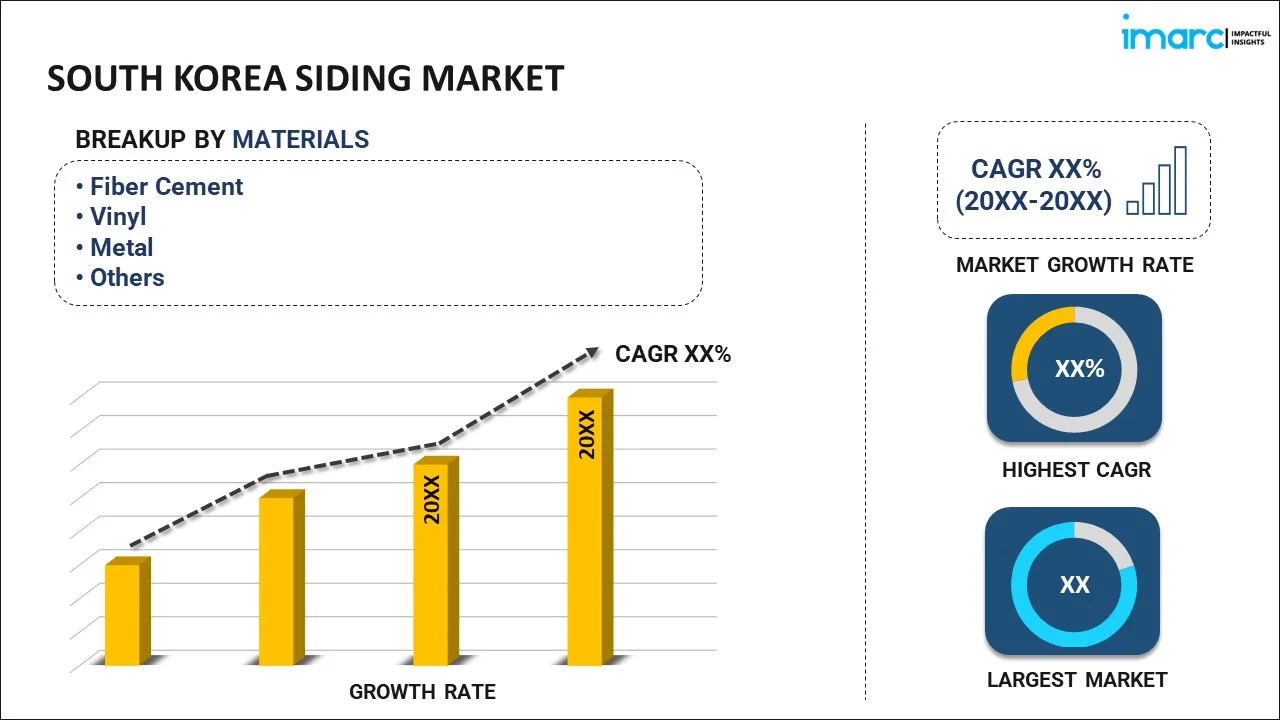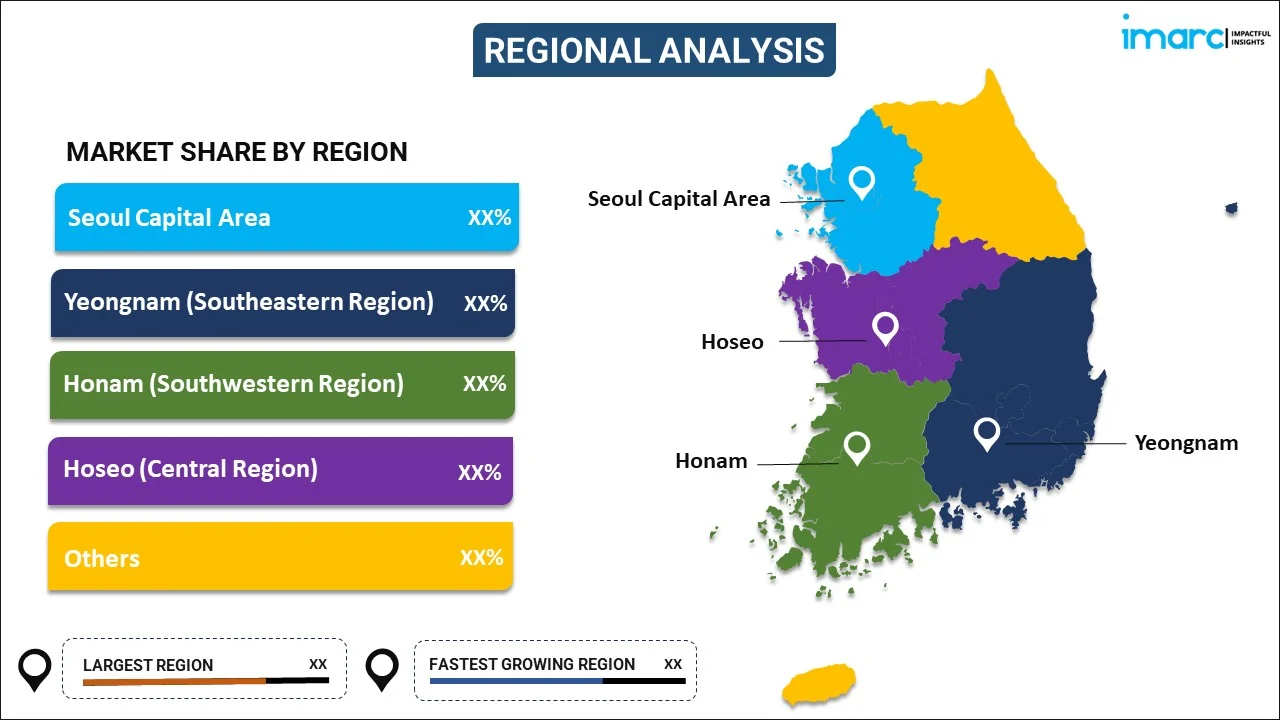
South Korea Siding Market Report by Material (Fiber Cement, Vinyl, Metal, Stucco, Concrete and Stone, Brick, Wood, and Others), End Use (Residential, Non-Residential), Application (New Construction, Repair and Maintenance), and Region 2025-2033
Market Overview:
South Korea siding market size is projected to exhibit a growth rate (CAGR) of 2.8% during 2025-2033. The inflating need for reducing heating and cooling costs and making buildings more environmentally sustainable and economically efficient is primarily driving the market growth across the country.
|
Report Attribute
|
Key Statistics
|
|---|---|
|
Base Year
|
2024 |
|
Forecast Years
|
2025-2033
|
|
Historical Years
|
2019-2024
|
| Market Growth Rate (2025-2033) | 2.8% |
Siding, in the context of construction, refers to the outer cladding or covering of a building crafted from materials such as vinyl, wood, fiber cement, or aluminum. The installation process encompasses multiple stages, including the preparation of the building's exterior, the attachment of siding panels, and the inclusion of finishing elements like trim and caulking. It is applied to both the roof and walls in various forms and styles like clapboard, shingles, shakes, verticals, and panels, tailored to the user's specifications. The primary purpose of siding is to furnish a protective layer on a building's exterior, shielding it from adverse weather conditions like wind, rain, and snow to prevent potential damage to the structure and its interior. Additionally, siding contributes to the aesthetic appeal of a building, introducing visual interest and stylistic elements. Moreover, it enhances a building's energy efficiency by providing supplementary insulation, thereby reducing heating and cooling expenses and creating a more comfortable indoor environment.
South Korea Siding Market Trends:
The South Korea siding market stands as a pivotal segment within the country's construction and real estate industries, showcasing a diverse range of materials and styles that contribute to both functional and aesthetic aspects of buildings. Installation of siding in South Korea involves a meticulous process, including the preparation of the building's exterior, attaching siding panels, and incorporating finishing details like trim and caulking. Additionally, various shapes and styles, such as clapboard, shingles, shakes, verticals, and panels, are applied to roofs and walls based on user preferences and architectural requirements. Besides this, beyond its structural role, siding in South Korea plays a vital function in protecting buildings from the diverse weather conditions prevalent in the region. Besides this, siding enhances the curb appeal of buildings, introducing visual interest and stylistic elements that contribute to the overall aesthetic of neighborhoods and communities. As the construction industry in South Korea continues to evolve, the siding market will remain integral, offering a blend of functionality, protection, and aesthetic appeal to a wide range of buildings across the nation in the coming years.
South Korea Siding Market Segmentation:
IMARC Group provides an analysis of the key trends in each segment of the market, along with forecasts at the country level for 2025-2033. Our report has categorized the market based on material, end use, and application.
Material Insights:

- Fiber Cement
- Vinyl
- Metal
- Stucco
- Concrete and Stone
- Brick
- Wood
- Others
The report has provided a detailed breakup and analysis of the market based on the material. This includes fiber cement, vinyl, metal, stucco, concrete and stone, brick, wood, and others.
End Use Insights:
- Residential
- Non-Residential
- Healthcare
- Education
- Hospitality
- Retail
- Offices
- Others
A detailed breakup and analysis of the market based on the end use have also been provided in the report. This includes residential and non-residential (healthcare, education, hospitality, retail, offices, and others).
Application Insights:
- New Construction
- Repair and Maintenance
The report has provided a detailed breakup and analysis of the market based on the application. This includes new construction and repair and maintenance.
Regional Insights:

- Seoul Capital Area
- Yeongnam (Southeastern Region)
- Honam (Southwestern Region)
- Hoseo (Central Region)
- Others
The report has also provided a comprehensive analysis of all the major regional markets, which include Seoul Capital Area, Yeongnam (Southeastern Region), Honam (Southwestern Region), Hoseo (Central Region), and Others.
Competitive Landscape:
The market research report has also provided a comprehensive analysis of the competitive landscape. Competitive analysis such as market structure, key player positioning, top winning strategies, competitive dashboard, and company evaluation quadrant has been covered in the report. Also, detailed profiles of all major companies have been provided.
South Korea Siding Market Report Coverage:
| Report Features | Details |
|---|---|
| Base Year of the Analysis | 2024 |
| Historical Period | 2019-2024 |
| Forecast Period | 2025-2033 |
| Units | Million USD |
| Scope of the Report | Exploration of Historical Trends and Market Outlook, Industry Catalysts and Challenges, Segment-Wise Historical and Future Market Assessment:
|
| Materials Covered | Fiber Cement, Vinyl, Metal, Stucco, Concrete and Stone, Brick, Wood, Others |
| End Uses Covered |
|
| Applications Covered | New Construction, Repair and Maintenance |
| Regions Covered | Seoul Capital Area, Yeongnam (Southeastern Region), Honam (Southwestern Region), Hoseo (Central Region), Others |
| Customization Scope | 10% Free Customization |
| Post-Sale Analyst Support | 10-12 Weeks |
| Delivery Format | PDF and Excel through Email (We can also provide the editable version of the report in PPT/Word format on special request) |
Key Questions Answered in This Report:
- How has the South Korea siding market performed so far and how will it perform in the coming years?
- What has been the impact of COVID-19 on the South Korea siding market?
- What is the breakup of the South Korea siding market on the basis of material?
- What is the breakup of the South Korea siding market on the basis of end use?
- What is the breakup of the South Korea siding market on the basis of application?
- What are the various stages in the value chain of the South Korea siding market?
- What are the key driving factors and challenges in the South Korea siding?
- What is the structure of the South Korea siding market and who are the key players?
- What is the degree of competition in the South Korea siding market?
Key Benefits for Stakeholders:
- IMARC’s industry report offers a comprehensive quantitative analysis of various market segments, historical and current market trends, market forecasts, and dynamics of the South Korea siding market from 2019-2033.
- The research report provides the latest information on the market drivers, challenges, and opportunities in the South Korea siding market.
- Porter's five forces analysis assist stakeholders in assessing the impact of new entrants, competitive rivalry, supplier power, buyer power, and the threat of substitution. It helps stakeholders to analyze the level of competition within the South Korea siding industry and its attractiveness.
- Competitive landscape allows stakeholders to understand their competitive environment and provides an insight into the current positions of key players in the market.
Need more help?
- Speak to our experienced analysts for insights on the current market scenarios.
- Include additional segments and countries to customize the report as per your requirement.
- Gain an unparalleled competitive advantage in your domain by understanding how to utilize the report and positively impacting your operations and revenue.
- For further assistance, please connect with our analysts.
 Request Customization
Request Customization
 Speak to an Analyst
Speak to an Analyst
 Request Brochure
Request Brochure
 Inquire Before Buying
Inquire Before Buying




.webp)




.webp)












